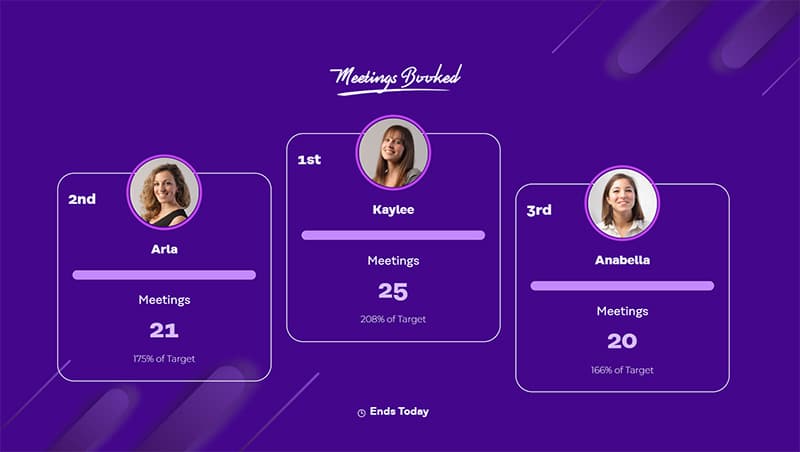Gamification is a technique used to boost employee engagement by applying game elements in a non-game context, such as the workplace. As much as it is inspired by games, its purpose is to motivate and keep employees engaged. Some common gamification features include badges, leaderboards, and rewards for accomplishments.
Companies organize internal competitions that include points, levels, and rewards as an added incentive to get staff moving in a positive “race.” According to a recent TalentLMS survey on gamification, 61% of individuals who receive non-gamified training feel bored and unproductive, compared to 83% of those who feel inspired after receiving gamified training.
Introducing gamification at the workplace is an excellent way to boost employee morale and improve their mood. Studies have shown that the majority of employees admit to feeling happier at work as a result of gamification. Gamification can also be used to improve employee engagement, and we see many types of game elements in programs like employee training and elearning courses.
Below are some tips on incorporating Gamification features in the workplace.
1. Make the rules of the game known
To avoid an unfair race, the rules must be stated clearly at the beginning. Attach company goals to the game and tell your employees’ teams about them. Explain to them the criteria by which they will know they have won. Offer desirable rewards to be won by the employees with the most points and the runners-up. This should help the employees feel motivated to participate. This also gives life to the competitive element of the gamification strategy.
Explain to the employees how achieving the goals impacts the business goals as well as them individually. Make the employees aware of actions that will disqualify them. Purpose is just as important as achievement; it adds to the employee’s self-motivation to complete even the boring tasks.
2. Incorporate gamification in training employees.
Gamification in the workplace will blend in more naturally when it is part of an employee training strategy. The ability to measure and visually represent success in a way that is socially visible is necessary for gamification to increase employee engagement. All of those criteria are met by badges and accomplishments, which function both with and without reward points. Some popular gamification features include:
Gamification in the workplace will blend in more naturally when it is part of an employee training strategy. The ability to measure and visually represent success in a way that is socially visible is necessary for gamification to increase employee engagement. All of those criteria are met by badges and accomplishments, which function both with and without reward points. Some popular gamification features include:
Leaderboards

Employees can compete to rank highest by earning the most points. This can be achieved by completing tasks. An interesting workplace and higher employee productivity can both be achieved with a little friendly rivalry. A method to make this rivalry more game-like and quantifiable is to create a leaderboard based on points. Sales representatives and other top-performing employees who want to be the best will find this employee gamification strategy very beneficial!
Points
Employees can earn points by completing tasks, successfully completing a training course, or achieving certain results.
Badges
Exemplary behavior by employees should be recognized with badges. This would help encourage employees to always be on their best behavior and improve their overall job performance.
Other rewards
Offer your employees more desirable rewards, such as vouchers, discounts, and other real-world rewards. Rewards being offered need to appeal and be relevant to the employee. Not everyone is after the same reward. Badges can only motivate employees for so long.
Reward exceptional achievements, such as those of a star employee, with bigger incentives like an all-expenses-paid weekend getaway at a world-class hotel.
4. Recognize everyone’s contribution
Other employees prefer to be given credit for their input as a reward for their great job performance. Make it a point to recognize everyone’s contribution in the workplace.
When using gamification to improve employee participation, it is important for everyone to feel like it is worth participating in. Explore various rewards you can offer to employees who manage to complete workplace challenges, complete a training course, or surpass set milestones.
By introducing some spontaneity, intermittent rewards raise employee engagement. Additionally, employees are more likely to learn and practice behaviors that are beneficial to your firm when they receive unexpected benefits. Instant certificates of appreciation are a simple and effective way to add some fun to the workplace.
5. Observe the effectiveness of gamification in the workplace
With your new gamification initiative, it is wise to measure the successes and failures that have been brought about by the implementation of a new learning management system.
Take note of factors like the number of employees who participate. How many employees made an effort to complete the goals? How much did the overall job performance improve during and after the implementation of a gamification program?
If your statistics are on the low side, you might want to rethink your criteria for rewarding your employees. Consider including some quality-of-life rewards to improve employee engagement. This is the best way to improve your gamification strategy: by keeping track of and analyzing the relevant data.
6. A recap of the performance of the gamification program
Perform a reflection at the end of every challenge, during which both the top successes and the failures of the program are analyzed. Ensure to put emphasis on individual employees’ achievements so others can learn from them.
Implementing the gamification initiative in the workplace
Once you have the foundational knowledge of what gamification in the workplace entails, it is time to execute the plan. Gamification at work might be just fun, non game activities for your employees. You, on the other hand, need to handle all the office work that comes with gamification in the workplace.
Adding game elements to regular activities in the workplace creates a sense of comfort among the employees and can lead to an increase in productivity. It is especially useful when seeking immediate feedback from employees through rewards and public recognition. You can motivate employees and improve employee engagement by undertaking frequent surveys and issuing instant rewards to compliant and participating employees.
Gamification at work helps to improve employee onboarding. The social aspect of gamification lies in helping employees establish a healthy sense of competition as well as motivating employees who are younger and have a less significant role in the workplace. Gamification in the workplace is a common approach used, especially by managers with remote workers, to boost employee engagement.
Benefits of gamification in the workplace
You can accrue most, if not all the benefits of gamification at work; especially if it is incorporated when training employees. Gamification is especially useful when the members of the workforce are distributed across various locations and it is difficult to get some face time. Other benefits include:
1. It makes learning fun and engaging
Gamification improves the willingness of employees to learn in interactive ways increasing employee engagement. Disinterest in the content is a major learning barrier. Gamification helps employees by keeping the same employees actively involved in the learning processes.
2. It reduces the level of employee stress
A work environment built around stress is negative and gives rise to an unsatisfied workforce. The use of gamification in a work environment helps to motivate employees and increase productivity, which can improve employee outcomes.
3. It produces a loyal workforce
When a employees enjoy their work, they’re more inclined to stay. Gamification’s engaging, competitive and fun elements increase enjoyment in the workplace, making your team more likely to stick around!
Examples of gamification in the workplace
Gamification in the workplace as a concept has been around for quite a while. In order to get a mental picture of what gamification in action looks like, here are some examples.
The US Army
The US Army is famous for its training games, which are uniquely designed and sometimes even controversial. The game can be downloaded and tested out in a multiplayer setting. This promotes a healthy work culture by encouraging a united front within the workforce.
Deloitte
The onboarding process at Deloitte has been gamified and digitized and offers a perfect example of gamification at work. It allows newbies to team up together to learn about the functional parts of the company, such as compliance, ethics, and procedures.
Google maintains its interest in employees who travel a lot. All the money they manage to save when traveling is paid back to their salary or given to charity, depending on the individual’s personal preference.
Formapost
Formapost has been using gamification as a method of retention. From their analysis, they lost one in four workers during the first weeks. Their gamification program guides candidates through realistic job previews. Their early turnover dropped to 8% from 25% as a result.
Recruitainment
Recruitainment is when gamification is used in the hiring process, and companies are using it more and more. A lot of innovation can be observed in the recruitment space, especially when it comes to human resource technology.
Recruitment has never been something that should be taken lightly. Companies face a significant issue since poor hiring decisions can have disastrous effects. Candidates frequently experience stress during interviews because they feel overwhelmed by the intense scrutiny and worry that they won’t ever find work again.
A considerable percentage of candidates agree that recruitainment as a hiring process increases the desirability of a company. Another key feature of gamification in recruitment can be found in pre-employment assessment tools.
The Bottom Line
Gamification in the workplace has a positive impact on employee motivation, engagement, and work satisfaction. It has the ability to make work activities more fun and engaging. It also serves to improve the outlook of a business for its potential workforce.
It is not that easy, though. That’s because you need to access a superpower that many leaders and internal communications specialists overlook in order to properly use gamification in the workplace.
In all internal communications on the gamification process, be careful to accurately assess and gauge employees’ reactions. They’ve sent you emails on gamification in the workplace; are they opening them? Responding do they? You will be able to determine whether your staff is even on board with the idea in the first place by monitoring employee conversations using email tracking software.
If you are considering implementing gamification in your business or company, then you are headed in the right direction. Spinify’s gamification tools will thrill and motivate your employees to improve their job performance and productivity after you have a better grasp of what motivates them.
Book a demo today and see how we can help boost your team’s performance!



